American Condor
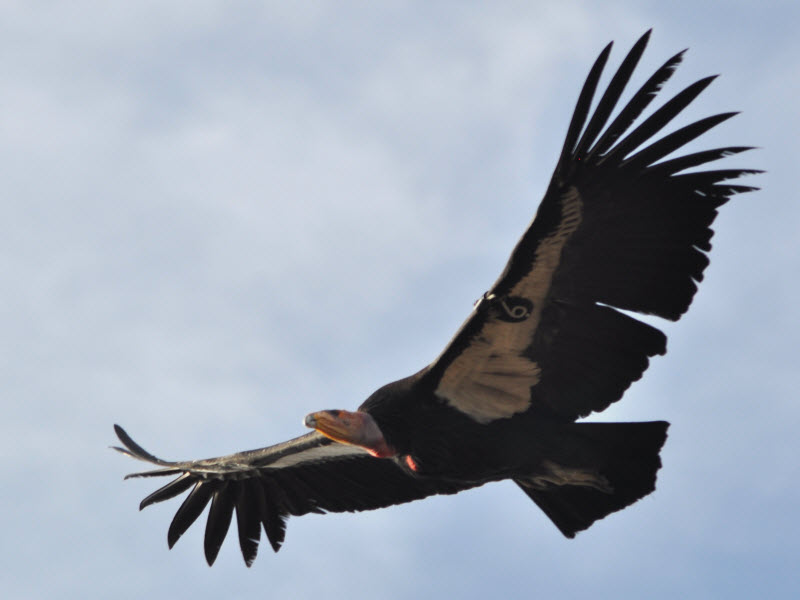
So much to know - an amazing story behind the existence of this bird in southern California. The condor was extinct in the wild in 1980 - the population had fallen to 22 birds or so, and all remaining condors were captured and placed in either of two zoos, where care over ensuing years led to a growing population and steady release into the wild - to the point where today there are several hundred birds in the wild. When I looked up I thought I was seeing vultures - but not. These birds have a 10 foot wing span. Like vultures they have a head without feathers and feed on carcasses. They are magnificent birds, can fly to 15,000 feet, travel 150 miles in a day. I hiked with family up some 2,000 feet to Hawkins peak in Pinnacle National Park - and had a condor open its wings on a rock just above my head - breathtaking the size of the bird!

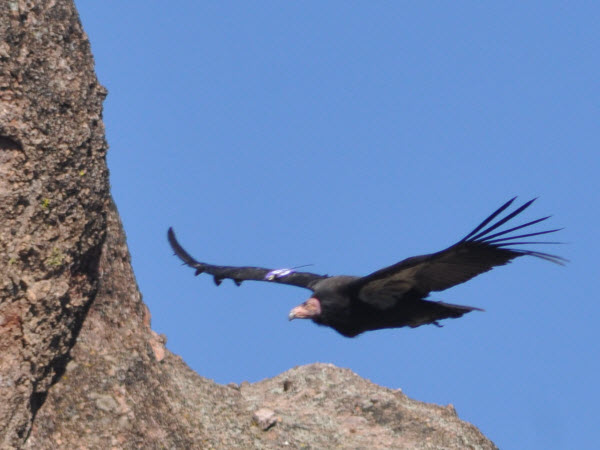
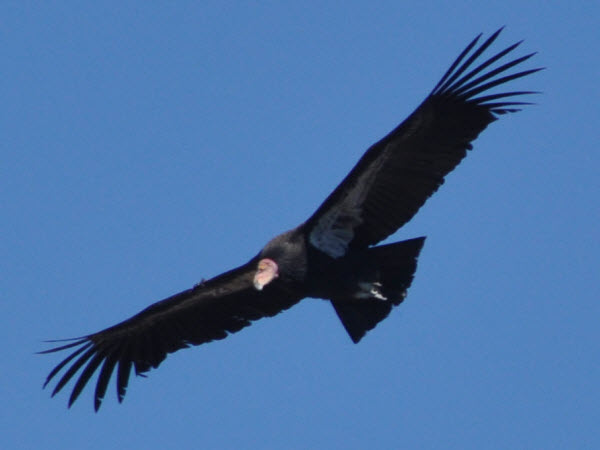
The photo at left was taken in 2018, a year later than most of the photos on this page. The tag on this condor looks to be a radio transmitter - there is an antenna clearly visible extending from the front edge of the wing straight back.
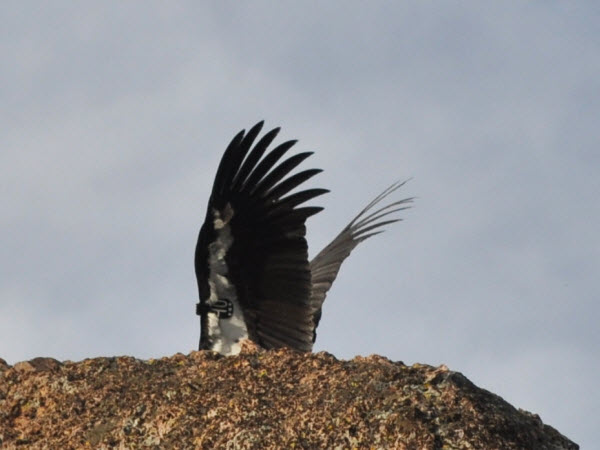
Wingspan of the condor is 10 feet - the widest of any North American bird, and weight is 26 pounds - equal to that of the trumpeter swan. The numbers, for me, just don't compare to the sight of a condor just feet away. Here a condor has opened their wings to take flight, perched just out of sight on a rock over my head. The size of these wings took my breath away!
Ref: https://en.wikipedia.org/wiki/California_condor
Notice the wing tag - a black tag with the number 40 and three dots.
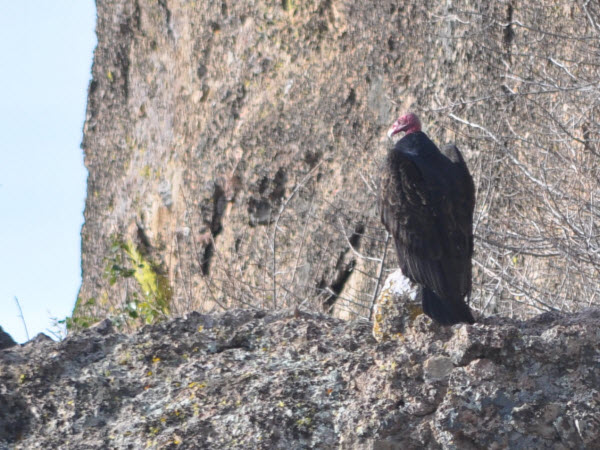


Juvenile condor - the bird with the green tag, 26, has a black head. I so identify both the condor and the turkey vulture by that distinctive pink, featherless head that I had to look this one up. It is the same pair of birds in the photo above and to the left. It is a little difficult to make out the head at first in these images - the birds are on a rock face one peak over from me - a pretty good distance for a 300mm lens - would not work for me without a tripod. Two mature adults are nearby.
The condors have a featherless head - similar to the vulture. See the reference: https://en.wikipedia.org/wiki/California_condor - "Why do California condors have bald heads?"
Taking directly from this article - condors are scavengers, living on a diet of carrion. The lack of feathers on their head prevent food material from sticking to the birds head when it feeds, since it will frequently stick its entire head into a carcass. The condor is a fastidious bird - after feeding, it routinely cleans itself by bathing in a nearby body of water. If there is no water around, it will simply rub its head and neck on nearby grass or rocks, and will spend hours cleaning, drying and fluffing its feathers.
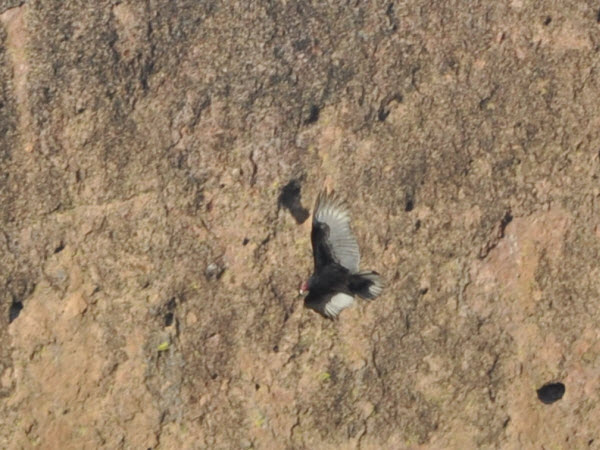
A condor is gliding in front of a rock face. In most views the feathers are black, with striking white patches under the wings. This can be seen in the images here, and is true of the bird in this photo above, as well. There was a group of half a dozen condors present on this day, and as they glided in front of the rock face, there was one angle when the white visible in this image became apparent.
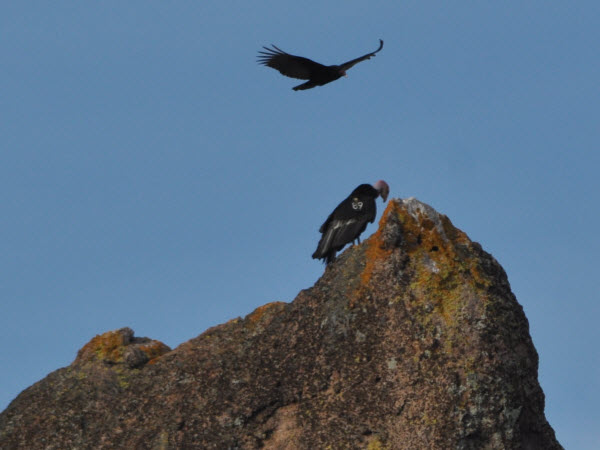
It is hard to judge the size of a bird from afar, and I initially dismissed these condors as turkey vultures - the black feathers, fingered tips and bald red head. But there is also the flight and how the wings are held. The condor has a heavy, stable flight style with almost no flapping. When they do flap, it is usually a single, deep wingbeat with the wingtips almost meeting on the downstroke. Turkey vultures hold their wings above the horizontal and are much less stable in flight, constantly teetering or rocking as they soar. I could see that the flight pattern of these birds was not consistent with a vulture, and asked another hiker - who told me these were California condors, with much enthusiasm!
ref: https://www.allaboutbirds.org/guide/California_Condor/id The Cornell Lab of Ornithology
See the wing tag - a black tag with the number 89.
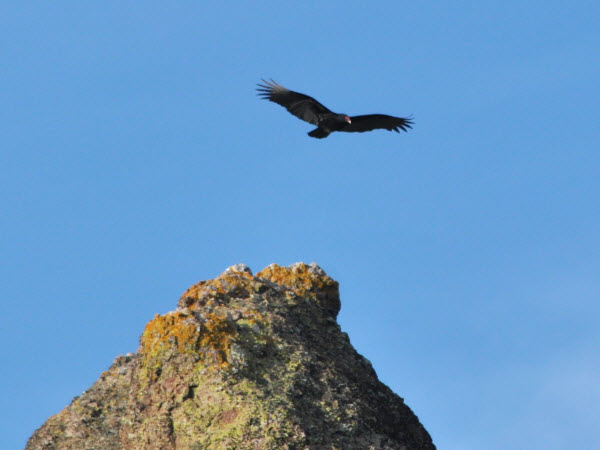
This image shows clearly the wings out horizontally, with long primary feathers giving a fingered look to the wingtips, bulky body, small head and short, broad tail.
ref: https://www.allaboutbirds.org/guide/California_Condor/id
Hawkins peak, in Pinnacle National Park, is a steady grade for most of the way up - except at the very top. Small steps have been notched into the rock, and a hand rail erected for that last part!
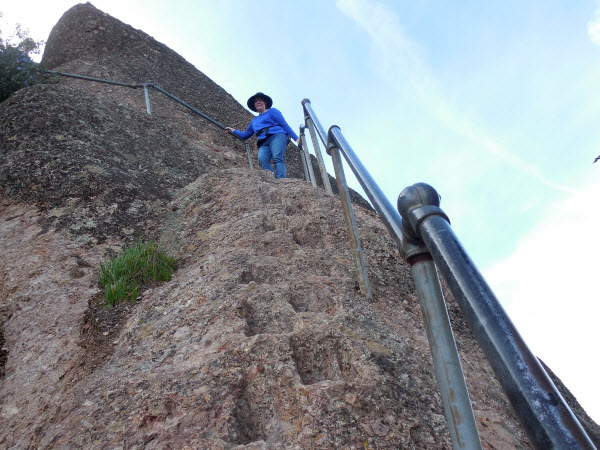
The condor was entirely extinct from the wild in 1987, present only as 27 birds housed in two captive breeding facilities in southern California. There are numerous web sites that relate the story - much better to read from these sites - four references that I particularly like:
http://ventanaws.org/ Ventana Wildlife Society - Clearly at the center of the effort to recover a breeding population of the condor.
https://www.fws.gov/cno/es/CalCondor/CondorCount.cfm US Fish and Wildlife Service - Condor count and recovery information.
http://www.dfg.ca.gov/wildlife/nongame/t_e_spp/condor/ California Department of Fish and Wildlife - California Condor.
https://www.nps.gov/pinn/learn/nature/leadinfo.htm National Park Service - Lead Bullet Risks for Wildlife and Humans.
These sites and others have much to read. Here I am thinking of only one part of the story - the contribution of lead to the near extinction of the condor, in addition to factors such as DDT and diminishing habitat. And so my selection of information from the references.
- Numerous scientific studies have reached the consensus that lead poisoning is the biggest threat facing the successful recovery of the California condor - from lead fragments in carcasses.
- The third reference, "Lead bullet risks for wildlife and humans" documents in detail how a lead rifle bullet expands and loses hundreds of tiny pieces when it hits animal tissue - tissue that may then be ingested by condors.
- Condors currently in the wild are routinely captured and tested for lead blood levels - the majority of free-flying condors have blood levels that exceed 10Ug/dL (microgram / decaLiter) - the threshold used by the CDC that a human child is at risk, and lead blood levels as high as 570Ug/dL have been measured. Condors with high lead blood levels receive emergency, life saving chelation treatment.
- In 1987 the last wild condor was captured. At that time there were 27 birds, housed in two captive breeding facilities in southern California. Genetic studies identify three genetic groups, or "clans" within this population, and captive breeding has been managed to minimize loss of genetic diversity.
- About 20 chicks hatch each year, now at three captive breeding centers. Captive-bred condors have been released to the wild in southern California since 1992, and also in Arizona and Baja California, Mexico. In 2014 there were a total of 421 condors - 192 captive and 228 free.
- Every condor has been assigned an identification "studbook" number, encoded on a wing tag. The number on the wing tag is the last one or two digits of the studbook number. So, a wing tag that reads "19" could be condor #19 or #119 or #219 or #319 or #419. The color of the tag indicates the 100s series, 200, 300, and so on.
There is so much more to know and read about the condor - follow the links to the references!